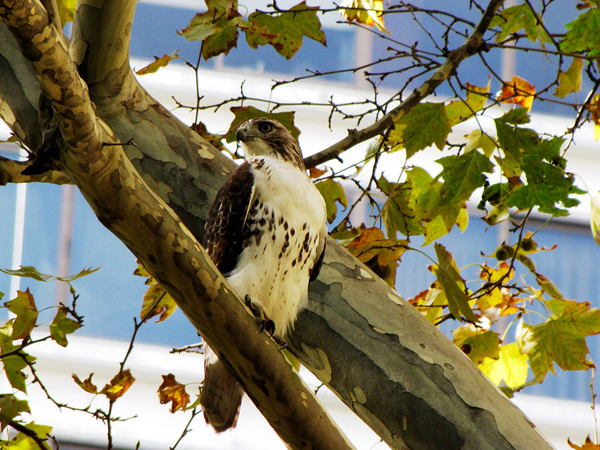 An urban environment is no deterrent to hawk watching
An urban environment is no deterrent to hawk watching
by Bernard Brown, phillyherping.blogspot.com
On this particular morning, the pigeons were smarter than the squirrels. Walking from my office to the ATM, I noticed breadcrumbs strewn across a stretch of sidewalk in Washington Square Park. A pair of young squirrels took turns jumping on each other and tussling in the grass nearby, but nary a pigeon was there to peck up the crumbs.
When a Red-tailed hawk swooped in, I was just as surprised as the squirrels. The hawk missed both of them, thudding into the grass (klutz!) as the squirrels separated and bolted for the trees. Was this some kind of staged nature documentary? (Cue the grim narrator: “The innocent squirrels play, completely unaware that death stalks them from above!”) I looked around at the office and apartment buildings, Independence Hall just a block away—no cameras. The hawk mounted a few more lame attacks before giving up and flying away.
A few winters ago, a Cooper’s Hawk in a Roxborough apartment complex had better luck. My wife and I walked into the courtyard and found it butchering a pigeon, scattering feathers and blood all over the clean snow. We stared impolitely; the hawk looked up for an awkward moment and then flew away with its limp, gory dinner.
That Cooper’s Hawk (a member of Accipiter genus, faster, more slender hawks than the bulkier red-tails and their Buteo cousins) was onto something. We might think of cities as artificial, tame places, but they’re overflowing with hawk food: lazy squirrels and flocks of breadcrumb-stuffed pigeons.
You can see some rarer species in our wilder corners—the harriers nesting at the Heinz National Wildlife Refuge come to mind—but the ones you’re most likely to spot in the city (perched on a light post or tree branch) are Red-tails. I saw one this morning in a Southwest Philly cemetery; it was screaming indignantly as a smaller bird dive-bombed, chasing it away.
The Franklin Institute also hosts a red-tailed nest outside its conference room window. You can watch the parents feed fresh squirrel bits to the babies on their hawk nest video stream
(fi.edu/hawks/). This year’s chicks have fledged, but you can check out the family pictures while you ready for next spring.
Tired of our local hawks? Check out the big fall raptor migration from August through November. We’re lucky to be right near a major migration highway, particularly along the Kittatiny Ridge, where raptors from points north make their way south for the winter. You can watch from spots with evocative names such as Bake Oven Knob or—in a lovely bit of plainspeak—Hawk Mountain. You can also make the much shorter trip to Rose Tree Park in Media, where the local Hawk Watch (rtphawkwatch.org) keeps track of fly-overs and can help you tell the Broad Wings from the Sharp Shins.


